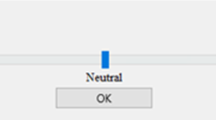Abstract
The aim of the paper is to highlight the necessity of applying the concept of constrained fuzzy arithmetic instead of the concept of standard fuzzy arithmetic in a fuzzy extension of Analytic Hierarchy Process (AHP). Emphasis is put on preserving the reciprocity of pairwise comparisons during the computations. For deriving fuzzy weights from a fuzzy pairwise comparison matrix, we consider a fuzzy extension of the geometric mean method and simplify the formulas proposed by Enea and Piazza (Fuzzy Optim Decis Mak 3:39–62, 2004). As for the computation of the overall fuzzy weights of alternatives, we reveal the inappropriateness of applying the concept of standard fuzzy arithmetic and propose the proper formulas where the interactions among the fuzzy weights are taken into account. The advantage of our approach is elimination of the false increase of uncertainty of the overall fuzzy weights. Finally, we advocate the validity of the proposed fuzzy extension of AHP; we show by an illustrative example that by neglecting the information about uncertainty of intensity of preferences we lose an important part of knowledge about the decision making problem which can cause the change in ordering of alternatives.

Similar content being viewed by others
References
Buckley, J. J. (1985). Fuzzy hierarchical analysis. Fuzzy Sets and Systems, 17(3), 233–247.
Chang, D. Y. (1996). Applications of the extent analysis method on fuzzy AHP. European Journal of Operational Research, 95(3), 649–655.
Crawford, G., & Williams, C. A. (1985). A note on the analysis of subjective judgment matrices. Journal of Mathematical Psychology, 29(4), 387–405.
Dubois, D. (2011). The role of fuzzy sets in decision sciences: Old techniques and new directions. Fuzzy Sets and Systems, 184(1), 3–28.
Enea, M., & Piazza, T. (2004). Project selection by constrained fuzzy AHP. Fuzzy Optimization and Decision Making, 3(1), 39–62.
Güngör, Z., Serhadlioglu, G., & Kesen, S. E. (2009). A fuzzy AHP approach to personnel selection problem. Applied Soft Computing, 9(2), 641–646.
Ishizaka, A., & Nguyen, N. H. (2013). Calibrated fuzzy AHP for current bank account selection. Expert Systems with Applications, 40, 3775–3783.
Klir, G. J., & Yuan, B. (1998). Constrained fuzzy arithmetic: Basic questions and some answers. Soft Computing, 2(2), 100–108.
Krejčí, J., & Stoklasa, J. (2015). Fuzzified AHP in the evaluation of scientific monographs. Central European Journal of Operations Research. doi:10.1007/s10100-015-0399-2.
Pan, N.-F. (2008). Fuzzy AHP approach for selecting the suitable bridge construction method. Automation in Construction, 17(8), 958–965.
Pavlačka, O. (2011). Modeling uncertain variables of the weighted average operation by fuzzy vectors. Information Sciences, 181(22), 4969–4992.
Pavlačka, O. (2014). On various approaches to normalization of interval and fuzzy weights. Fuzzy Sets and Systems, 243, 110–130.
Ramík, J., & Korviny, P. (2010). Inconsistency of pair-wise comparison matrix with fuzzy elements based on geometric mean. Fuzzy Sets and Systems, 161(11), 1604–1613.
Ramík, J. (2015). Isomorphisms between fuzzy pairwise comparison matrices. Fuzzy Optimization and Decision Making, 14(2), 199–209.
Saaty, T. L. (1980). The analytic hierarchy process. New York: McGraw Hill.
Saaty, T. L. (2006). There is no mathematical validity for using fuzzy number crunching in the analytic hierarchy process. Journal of Systems Science and Systems Engineering, 15(4), 457–464.
Saaty, T. L., & Tran, L. T. (2007). On the invalidity of fuzzifying numerical judgments in the analytic hierarchy process. Mathematical and Computer Modelling, 46, 962–975.
Subramanian, N., & Ramanathan, R. (2012). A review of applications of analytic hierarchy process in operations management. International Journal of Production Economics, 138, 215–241.
Tesfamariam, S., & Sadiq, R. (2006). Risk-based environmental decision-making fuzzy analytic hierarchy process (F-AHP). Stochastic Environmental Research and Risk Assessment, 21, 35–50.
Tiryaki, F., & Ahlatcioglu, A. (2009). Fuzzy portfolio selection using fuzzy analytic hierarchy process. Information Sciences, 179(1–2), 53–69.
Vahidnia, M. H., Alesheikh, A. A., & Alimohammadi, A. (2009). Hospital site selection using fuzzy AHP and its derivatives. Journal of Environmental Management, 90(10), 3048–3056.
Van Laarhoven, P. J. M., & Pedrycz, W. (1983). A fuzzy extension of Saaty’s priority theory. Fuzzy Sets and Systems, 11(1–3), 199–227.
Wang, Y. M., & Elhag, T. M. S. (2006). On the normalization of interval and fuzzy weights. Fuzzy Sets and Systems, 157(18), 2456–2471.
Wang, Y. M., Luo, Y., & Hua, Z. (2008). On the extent analysis method for fuzzy AHP and its applications. European Journal of Operational Research, 186(2), 735–747.
Yuen, K. K. F. (2014). Combining compound linguistic ordinal scale and cognitive pairwise comparison in the rectified fuzzy TOPSIS method for group decision making. Fuzzy Optimization and Decision Making, 13(1), 105–130.
Zadeh, L. A. (1975). Concept of a linguistic variable and its application to approximate reasoning I. Information Sciences, 8(3), 199–249.
Zadeh, L. A. (1975). Concept of a linguistic variable and its application to approximate reasoning II. Information Sciences, 8(4), 301–357.
Zadeh, L. A. (1975). Concept of a linguistic variable and its application to approximate reasoning III. Information Sciences, 9(1), 43–80.
Zheng, G., Zhu, N., Tian, Z., Chen, Y., & Sun, B. (2012). Application of a trapezoidal fuzzy AHP method for work safety evaluation and early warning rating of hot and humid environments. Safety Science, 50(2), 228–239.
Author information
Authors and Affiliations
Corresponding author
Additional information
Research has been supported by the project No. GA 14-02424S Methods of operations research for decision support under uncertainty of the Grant Agency of the Czech Republic.
Rights and permissions
About this article
Cite this article
Krejčí, J., Pavlačka, O. & Talašová, J. A fuzzy extension of Analytic Hierarchy Process based on the constrained fuzzy arithmetic. Fuzzy Optim Decis Making 16, 89–110 (2017). https://doi.org/10.1007/s10700-016-9241-0
Published:
Issue Date:
DOI: https://doi.org/10.1007/s10700-016-9241-0
Keywords
- Fuzzy Analytic Hierarchy Process
- Fuzzy pairwise comparison matrices
- Triangular fuzzy numbers
- Constrained fuzzy arithmetic
- Fuzzy weighted average




